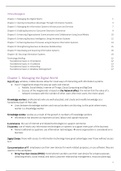Inhoudsopgave
Chapter 1: Managing the Digital World 1
Chapter 2: Gaining Competitive Advantage Through Information Systems 3
Chapter 3: Managing the Information Systems Infrastructure and Services 7
Chapter 4: Enabling Business-to-Consumer Electronic Commerce 9
Chapter 5: Enhancing Organisational Communication and Collaboration Using Social Media 10
Chapter 6: Enhancing Business Intelligence Using Information Systems 12
Chapter 7: Enhancing Business Processes using Enterprise Information Systems 14
Chapter 8: Strengthening Business-to-Business Relationships 15
Chapter 9: Developing and Acquiring Information Systems 16
Chapter 10: Securing Information Systems 19
Technology Briefing 22
Foundational topics in IS hardware 22
Foundational topics in IS software 23
Foundational topics in networking 23
Foundational topics in Database Management 27
Chapter 1: Managing the Digital World
Post-PC era: wireless, mobile devices allow for novel ways of interacting with information systems
• Five IT megatrends shape the way we work and interact
o Mobile, Social Media, Internet of Things, Cloud Computing and Big Data
o Success of the megatrends is based on the Network effect: the notion that the value of a
network increases with the number of other users (the more users, the more value)
Knowledge workers: professionals who are well educated; and create and modify knowledge as a
fundamental part of their jobs.
• Lines between knowledge workers and manual workers are blurring, to the point where every
worker is a knowledge worker
Knowledge society: society as a result of the growth in numbers of knowledge workers
• Information has become as important as land, labour and capital resources
E-commerce: the use of internet and related technologies to support commerce
E-business: use of nearly any information technologies or systems to support every part of the business
• Many traditional occupations use information technologies à every organisation is considered an e-
business
Digital Divide: those with access to information technology have great advantages over those without access
to it
Consumerisation of IT: employees use their own devices for work-related purposes; or use software they are
used to in the workplace
• Bring Your Own Device (BYOD): trend wherein workers use their own device for private purposes
(checking emails, social media) and tasks (customer relationship management, resource planning).
1
, o This can be worrying, or provide opportunities such as increased productivity and higher
retention rates of talented employees
Internet of things: broad range of physical objects (computers, sensors, motors) that are interconnected and
automatically share data over the internet.
Cloud Computing: use of internet as the platform for applications and data (e.g. accessed via web browser)
Waves of change: three distinct phases that have taken place in the past, or are presently taking place
within the world’s civilisation (Alvin Toffler)
Big Data: extremely large data sets that may be analysed computationally to reveal patterns, trends and
associations; especially relating to human behaviour and interactions
• Companies in the information era are creating value from data, not from people
Wearable Technology: clothing or accessories that incorporate electronic technologies (smart watch, fitness
tracker)
Computer Literacy: knowing how to use a computer à many argue it is not sufficient in this society, rather:
Computer Fluency: the ability to independently learn new technologies as they emerge and assess their
impact on one’s work and life
Information technology has enabled globalisation: the integration of economies throughout the world,
changing how people, organisations and countries interact
• Can be visible in
o Economic change: increase in international trade, outsourcing, development of global
financial systems and currency
o Cultural changes: increases in the availability of multiculturalism through tv/movies;
frequency of international travel, tourism, immigration; use of worldwide social media
o Technological change: the development of low-cost computing platforms and
communication technologies (skype, email); nature of low-cost telecommunication
infrastructure (internet)
Outsourcing: moving of business processes of tasks to another company
• Onshore: domestically
• Offshore: to another country
• Why outsource?
o Reduce/control costs
o Free up internal resources
o Gain access to world-class capabilities
o Increase the revenue potential of the organisation
o Reduce time to market
o Increase process efficiencies
2
, o Focus on a core activity
o Compensate for a lack of specific capabilities or skills
Information systems use information technology to collect, create and distribute useful data
• Information Technology: hardware, software, telecommunications network
• Good IS personnel possess knowledge and skill in three areas
o Technical: (hardware, software, networking and security)
o Business
o Systems (building and integrating systems, solving problems)
• Types of IS
o Transactions Processing Systems (TPS): efficiently process customer transaction and use data
for analytics
o Management Information System: where TPS data are sorted and organised to support
decision making
o Office Automation Systems: word processing, spreadsheets and other personal productivity
tools, enabling knowledge workers to accomplish their tasks (excel, word)
Data: most basic element of any information system à raw symbols
• No meaning in and of themselves
• Of little value until processed
• Can be formatted, organised or processed to be useful à transformed into information
• To use this information, knowledge is needed: ability to understand information, form opinions and
make decisions or predictions with the information
When systems cannot be categorised (e.g. supply chain management) they are referred to as:
• Internetworking: connecting hosts computers and their networks together to form larger network
• System Integration: connecting separate information systems and data to improve business
processes and decision making
Computer Ethics: moral issues and standards of conduct as they pertain to the use of information systems
Information privacy: what information an individual should have to reveal to others
Intellectual Property: creations of the mind that have commercial value (music, tv)
3D Printing: enables creating physical three-dimensional objects from digital models
Chapter 2: Gaining Competitive Advantage Through Information Systems
Business Processes: activities organisations perform to reach their business goals
3






